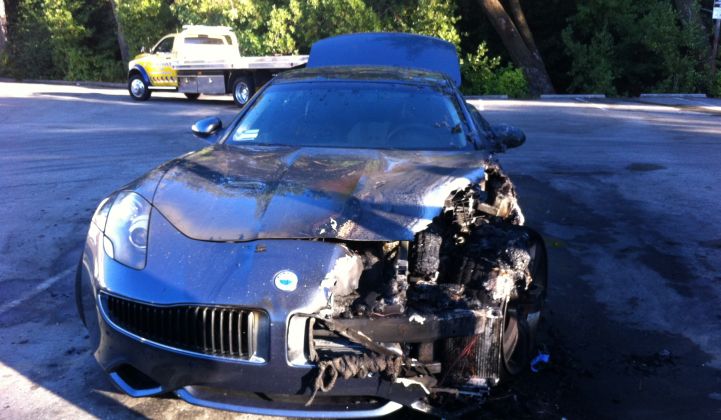Fisker Automotive’s proposed sale to a Hong Kong company formed by backers of the bankrupt hybrid vehicle startup appears to have hit a snag, with a competing bid emerging in the final hours from another contender: China’s Wanxiang Group.
That’s the news this week from U.S. Bankruptcy Court in Wilmington, Del., where unsecured creditors of Fisker are squaring off against Hybrid Technology, the company formed by Fisker backer and former director Richard Li. Hybrid Tech had been set to purchase Fisker’s assets out of bankruptcy as of the new year.
According to the Wall Street Journal, unsecured creditors have filed court documents objecting to Hybrid Technology’s proposed purchase and are seeking to pursue legal claims against the company. Hybrid Technology was formed late last year, and in November paid $25 million to purchase Fisker’s defaulted $192 million loan obligation to the Department of Energy, leaving taxpayers on the hook for the remaining $139 million.
In the meantime, Fisker’s unsecured creditors are supporting a rival bid by Wanxiang, the Chinese automotive manufacturing giant, which this week offered to pay $25.725 million for the bankrupt company’s assets and to take over some of Fisker’s debts, according to court documents. The bankruptcy court is scheduled to consider Fisker’s sale to Hybrid Tech on Friday, but unsecured creditors are pushing for an alternative auction for the company’s assets later this month, with Wanxiang as the leading bidder.
Wanxiang has its own ties to Fisker in the form of A123 Systems, the lithium-ion battery maker that it bought out of bankruptcy in January 2013. A123 made the batteries for Fisker’s Karma luxury hybrid sports car, and Wanxiang was reported to be considering a bid for Fisker in May of last year, before Fisker had filed for bankruptcy protection.
Fisker raised $1.2 billion from investors including VC firms Kleiner Perkins Caufield & Byers and NEA, as well as now-defunct investment firm Advanced Equities. It also drew down $192 million from its $528 million conditional loan granted under DOE’s Advanced Technology Vehicles Manufacturing Program (ATVM) to pay for a planned factory to build a lower-cost hybrid sedan in Delaware.
But Fisker ran into a series of insurmountable problems on its course toward insolvency. It stopped building its Karma hybrid sports cars in July 2012, and since then has been pummeled by bad reviews and reports of vehicle fires and recalls. Last year’s Hurricane Sandy destroyed a warehouse containing $30 million worth of Fisker’s already-built Karma sports cars.
At the same time, DOE cut off Fisker’s access to its loan in 2011 after the startup missed performance targets, and the agency put the balance of Fisker’s loan obligation on the auction block in October. At the time, DOE stated that it would “require all bids to include a commitment and business plan that promotes domestic manufacturing capabilities and related engineering for advanced technology vehicles here in the United States.” But it’s unclear whether that standard will require bidders to continue renovating the Delaware plant where Fisker had intended to produce its lower-cost Atlantic hybrid sedan.
Fisker certainly isn’t the only company that has failed to take on the legacy automotive industry via venture capital investment and government loans. Failed “green” vehicle companies include Coda Automotive, Think Global and Next Autoworks (formerly V-Vehicle), as well as plug-in EV charging companies Better Place and ECOtality, which both declared bankruptcy this year.
So far, Tesla Motors is the only venture-backed carmaker to succeed in breaking into real-world markets and posing a competitive threat to plug-in vehicles like the Chevy Volt and Nissan Leaf. Tesla has also paid off its DOE loan -- a positive development amidst a tough period for electric vehicle startups getting government assistance.



